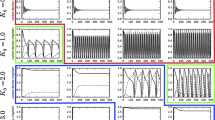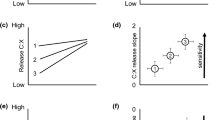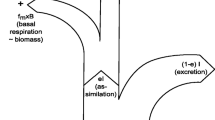Abstract
Nutritional constraints are common as food resources are rarely optimally suited for grazing species. Elemental mismatches between trophic levels can influence population growth and foraging behaviors. Grazing species, such as Daphnia, utilize optimal foraging techniques, such as compensatory feeding. Here, we develop two stoichiometric producer–grazer models, a base model that incorporates a fixed energetic foraging cost and an optimal foraging model where energetic foraging costs depend on food nutritional content. A variable energetic foraging cost results in cell quota-dependent predation behaviors. Analyzing and comparing these two models allows us to investigate the potential benefits of stoichiometric compensatory foraging behaviors on grazer populations. Optimal foraging strategies depend on environmental conditions, such as light and nutrient availability. In low-light conditions, fixed energetic foraging appears optimal regardless of the nutrient loads. However, in higher light conditions and intermediate nutrient loads, grazers utilizing compensatory foraging strategies gain an advantage. Overall, grazers can benefit from compensatory feeding behaviors when the food nutrient content of their prey becomes low or high.










Similar content being viewed by others
References
Acheampong E, Hense I, John MAS (2014) A model for the description of feeding regulation by mesozooplankton under different conditions of temperature and prey nutritional status. Ecol Model 272:84–97
Andersen T (1997) Pelagic nutrient cycles: herbivores as sources and sinks. Springer-Verlag, New York
Andersen T, Elser JJ, Hessen DO (2004) Stoichiometry and population dynamics. Ecol Lett 7(9):884–900
Cruz-Rivera E, Hay ME (2000) Can quantity replace quality? Food choice, compensatory feeding, and fitness of marine mesograzers. Ecology 81(1):201–219
Darchambeau F (2005) Filtration and digestion responses of an elementally homeostatic consumer to changes in food quality: a predictive model. Oikos 111(2):322–336
Diehl S (2007a) Paradoxes of enrichment: effects of increased light versus nutrient supply on pelagic producer-grazer systems. Am Nat 169(6):E173–E191
Diehl S (2007b) Paradoxes of enrichment: effects of increased light versus nutrient supply on pelagic producer-grazer systems. Am Nat 169(6):E173–E191
Elser JJ, Kyle M, Learned J, McCrackin ML, Peace A, Steger L (2016) Life on the stoichiometric knife-edge: effects of high and low food c: P ratio on growth, feeding, and respiration in three daphnia species. Inland Waters 6(2):136–146
Ermentrout B (2002) Simulating, analyzing, and animating dynamical systems: a guide to XPPAUT for researchers and students, vol 14. SIAM, Philadelphia
Holling CS (1965) The functional response of predators to prey density and its role in mimicry and population regulation. Memoirs Entomol Soc Canada 97(S45):5–60
Holling CS (1966) The functional response of invertebrate predators to prey density. Memoirs Entomol Soc Canada 98(S48):5–86
Li X, Wang H, Kuang Y (2011) Global analysis of a stoichiometric producer–grazer model with holling type functional responses. J Math Biol 63(5):901–932
Loladze I, Kuang Y, Elser JJ (2000) Stoichiometry in producer-grazer systems: linking energy flow with element cycling. Bull Math Biol 62(6):1137–1162
Mitra A, Flynn KJ (2007) Importance of interactions between food quality, quantity, and gut transit time on consumer feeding, growth, and trophic dynamics. Am Nat 169(5):632–646
Peace A (2015) Effects of light, nutrients, and food chain length on trophic efficiencies in simple stoichiometric aquatic food chain models. Ecol Model 312:125–135
Peace A, Zhao Y, Loladze I, Elser JJ, Kuang Y (2013) A stoichiometric producer-grazer model incorporating the effects of excess food-nutrient content on consumer dynamics. Math Biosci 244(2):107–115
Peace A, Wang H, Kuang Y (2014) Dynamics of a producer-grazer model incorporating the effects of excess food nutrient content on grazer’s growth. Bull Math Biol 76(9):2175–2197
Plath K, Boersma M (2001) Mineral limitation of zooplankton: stoichiometric constraints and optimal foraging. Ecology 82(5):1260–1269
Pyke GH, Pulliam HR, Charnov EL (1977) Optimal foraging: a selective review of theory and tests. Q Rev Biol 52(2):137–154
Schatz GS, McCauley E (2007) Foraging behavior by daphnia in stoichiometric gradients of food quality. Oecologia 153(4):1021–1030
Simpson SJ, Sibly RM, Lee KP, Behmer ST, Raubenheimer D (2004) Optimal foraging when regulating intake of multiple nutrients. Anim Behav 68(6):1299–1311
Sterner RW, Elser JJ (2002) Ecological stoichiometry: the biology of elements from molecules to the biosphere. Princeton University Press, Princeton
Sterner RW, Hessen DO (1994) Algal nutrient limitation and the nutrition of aquatic herbivores. Annu Rev Ecol Syst 25(1):1–29
Suzuki-Ohno Y, Kawata M, Urabe J (2012) Optimal feeding under stoichiometric constraints: a model of compensatory feeding with functional response. Oikos 121(4):569–578
Urabe J, Sterner RW (1996) Regulation of herbivore growth by the balance of light and nutrients. Proc Nat Acad Sci 93(16):8465–8469
Van Voorn GA, Kooi BW, Boer MP (2010) Ecological consequences of global bifurcations in some food chain models. Math Biosci 226(2):120–133
Wang H, Kuang Y, Loladze I (2008) Dynamics of a mechanistically derived stoichiometric producer-grazer model. J Biol Dyn 2(3):286–296
Xie T, Yang X, Li X, Wang H (2018) Complete global and bifurcation analysis of a stoichiometric predator-prey model. J Dyn Diff Equat 30(2):447–472
Acknowledgements
The first author is partially supported by NSF grant DMS-1615697. The second author is partially supported by an NSERC grant. We would like to thank Alan Hastings for the initial discussion when the second author visited his laboratory in 2015.
Author information
Authors and Affiliations
Corresponding author
Additional information
Publisher's Note
Springer Nature remains neutral with regard to jurisdictional claims in published maps and institutional affiliations.
Rights and permissions
About this article
Cite this article
Peace, A., Wang, H. Compensatory Foraging in Stoichiometric Producer–Grazer Models. Bull Math Biol 81, 4932–4950 (2019). https://doi.org/10.1007/s11538-019-00665-2
Received:
Accepted:
Published:
Issue Date:
DOI: https://doi.org/10.1007/s11538-019-00665-2




